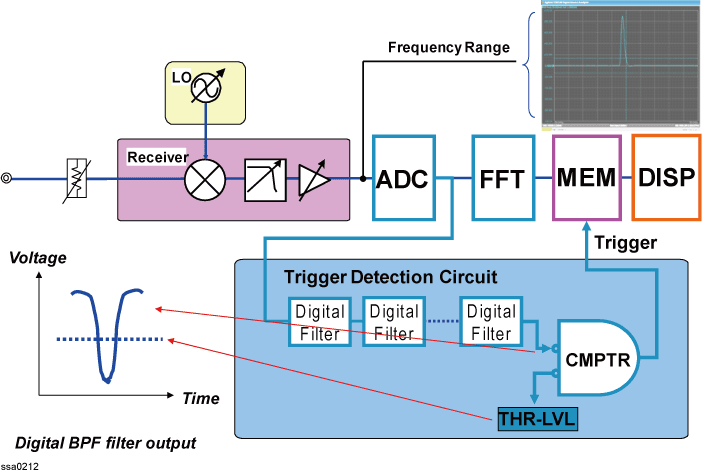Follow the steps below to set up the video trigger for the transient measurement:
In this case, change the power level of video trigger and frequency bandwidth to adjust the sensitivity of trigger. In addition, if the instrument is triggered even though the condition is not satisfied, improve the time resolution. This enables to see the frequency change that had not been seen before and to investigate the cause.
|
|
|
|
IN
|
The instrument is triggered when the input signal comes in the trigger standby band.
Adjustment is made so that the first measurement point when a signal comes in the standby band becomes the zero point of the time-axis.
When the video trigger is selected in this mode, two dotted lines indicating the upper and lower limits of the standby band are displayed on the graph of the frequency measurement.
|
|
OUT
|
The instrument is triggered when the input signal is outside the trigger standby band.
Adjustment is made so that the first measurement point when a signal goes outside the band becomes the zero point of the time-axis.
When the video trigger is selected in this mode, two dotted lines indicating the upper and lower limits of the standby band are displayed on the graph of the frequency measurement.
|
|
POSitive
|
The instrument is triggered when an input signal cuts across the trigger standby frequency from the lower frequency side to the higher frequency side.
Adjustment is made so that the point when an input signal cuts across the standby frequency becomes the zero point of the time-axis.
When the video trigger is selected in this mode, three dotted lines indicating the standby frequency, the upper limit and lower limit of the standby band are displayed on the graph of the frequency measurement.
|
|
NEGative
|
The instrument is triggered when an input signal cuts across the trigger standby frequency from the higher frequency side to the lower frequency side.
Adjustment is made so that the point when an input signal cuts across the standby frequency becomes the zero point of the time-axis.
When the video trigger is selected in this mode, three dotted lines indicating the standby frequency, the upper limit and lower limit of the standby band are displayed on the graph of the frequency measurement.
|
Assuming that max_width = fspan (span of the frequency range) × 1.1, choices of width for each range are as follows:
|
|
|
|
IN
|
The instrument is triggered when the input signal comes in the trigger standby band.
Adjustment is made so that the first measurement point when a signal comes in the standby band becomes the zero point of the time-axis.
When the video trigger is selected in this mode, two dotted lines indicating the upper and lower limits of the standby band are displayed on the graph of the frequency measurement.
|
|
OUT
|
The instrument is triggered when the input signal is outside the trigger standby band.
Adjustment is made so that the first measurement point when a signal goes outside the band becomes the zero point of the time-axis.
When the video trigger is selected in this mode, two dotted lines indicating the upper and lower limits of the standby band are displayed on the graph of the frequency measurement.
|
|
POSitive
|
The instrument is triggered when an input signal cuts across the trigger standby frequency from the lower frequency side to the higher frequency side.
Adjustment is made so that the point when an input signal cuts across the standby frequency becomes the zero point of the time-axis.
When the video trigger is selected in this mode, three dotted lines indicating the standby frequency, the upper limit and lower limit of the standby band are displayed on the graph of the frequency measurement.
|
|
NEGative
|
The instrument is triggered when an input signal cuts across the trigger standby frequency from the higher frequency side to the lower frequency side.
Adjustment is made so that the point when an input signal cuts across the standby frequency becomes the zero point of the time-axis.
When the video trigger is selected in this mode, three dotted lines indicating the standby frequency, the upper limit and lower limit of the standby band are displayed on the graph of the frequency measurement.
|
|
|
|
|
|
IN/OUT
|
80MHz
|
85MHz, 55MHz, 27.5MHz, 13.8MHz, 6.88MHz, 3.44MHz, 1.72MHz, 859kHz, 430kHz, 215kHz
|
|
25.6MHz
|
27.5MHz, 13.8MHz, 6.88MHz, 3.44MHz, 1.72MHz, 859kHz, 430kHz, 215kHz, 107kHz, 53.7kHz
|
|
1.6MHz
|
1.72MHz, 859kHz, 430kHz, 215kHz, 107kHz, 53.7kHz, 26.9kHz, 13.4kHz, 6.71kHz, 3.36kHz
|
|
200kHz
|
215kHz, 107kHz, 53.7kHz, 26.9kHz, 13.4kHz, 6.71kHz, 3.36kHz, 1.68kHz, 839Hz, 420Hz
|
|
25kHz
|
26.9kHz, 13.4kHz, 6.71kHz, 3.36kHz, 1.68kHz, 839Hz, 420Hz, 210Hz, 105Hz, 52.5Hz
|
|
3.125kHz
|
3.36kHz, 1.68kHz, 839Hz, 420Hz, 210Hz, 105Hz, 52.5Hz, 26.2Hz, 13.1Hz, 6.56Hz
|
|
POSitive / NEGative
|
80MHz
|
13.8MHz, 6.88MHz, 3.44MHz
|
|
25.6MHz
|
3.44MHz, 1.72MHz, 859kHz
|
|
1.6MHz
|
215kHz, 107kHz, 53.7kHz
|
|
200kHz
|
26.9kHz, 13.4kHz, 6.71kHz
|
|
25kHz
|
3.36kHz, 1.68kHz, 839Hz
|
|
3.125kHz
|
420Hz, 210Hz, 105Hz
|
